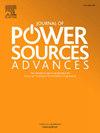Novel conductive and binding fibers for ultra-thick lithium-ion battery electrodes
IF 4.6
Q2 CHEMISTRY, PHYSICAL
引用次数: 0
Abstract
Using ultra-thick electrodes could be a promising strategy to increase the energy density of lithium-ion batteries. However, thickening electrodes leads to higher resistance for electron/ion transportation within the electrodes, resulting in a decrease in capacity and power. In addition, binder migration, which is a problem in the slurry coating process, becomes more pronounced. In this paper, we propose a novel fibrous conductive additive, conductive and binding fibers (CBFs), which are simply fabricated by combining two cost-effective materials—acetylene black and polyvinylidene fluoride—using electrospinning. We also report techniques to prepare CBF-based electrodes (CBFEs) using a solvent-free dry process. Morphological and electrochemical evaluations of the CBFEs (mass loading: 100 mg cm−2) reveal that the unique electrode structure formed by CBFs leads to high battery performance. The continuous efficient conductive networks formed by CBFs prevent electrical isolation of the active material particles. In addition, the CBFs serve as frameworks in electrodes because of their adhesion, forming larger pores (∼1 μm) and enhancing ion transport. Consequently, CBFEs achieve a discharge capacity of 91.9 mA h gAM−1 at 0.2C—a 1.6-fold improvement over conventional electrodes. The features of CBFs, which combine both conductivity and binding properties, enable the realization of a low-cost and high-performance electrode.

用于超厚锂离子电池电极的新型导电和粘结纤维
使用超厚电极可能是提高锂离子电池能量密度的一种很有前途的策略。然而,增厚的电极会导致电极内电子/离子传输的更高电阻,从而导致容量和功率的下降。此外,粘结剂迁移,这是一个问题,在浆料涂层过程中,变得更加明显。本文提出了一种新型的纤维导电添加剂——导电结合纤维(CBFs),该纤维是由两种具有成本效益的材料乙炔黑和聚偏氟乙烯静电纺丝合成的。我们还报告了使用无溶剂干燥工艺制备cbf基电极(CBFEs)的技术。对CBFs(质量负载为100 mg cm−2)的形态学和电化学评价表明,CBFs形成的独特电极结构导致了高性能的电池。由CBFs形成的连续高效导电网络防止了活性物质颗粒的电隔离。此外,由于CBFs具有粘附性,因此可以在电极中充当框架,形成更大的孔(~ 1 μm)并增强离子传输。因此,CBFEs在0.2℃下的放电容量为91.9 mA h gAM−1,比传统电极提高了1.6倍。CBFs结合了导电性和结合性的特点,使其能够实现低成本和高性能的电极。
本文章由计算机程序翻译,如有差异,请以英文原文为准。
求助全文
约1分钟内获得全文
求助全文

 求助内容:
求助内容: 应助结果提醒方式:
应助结果提醒方式:


